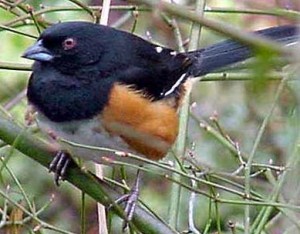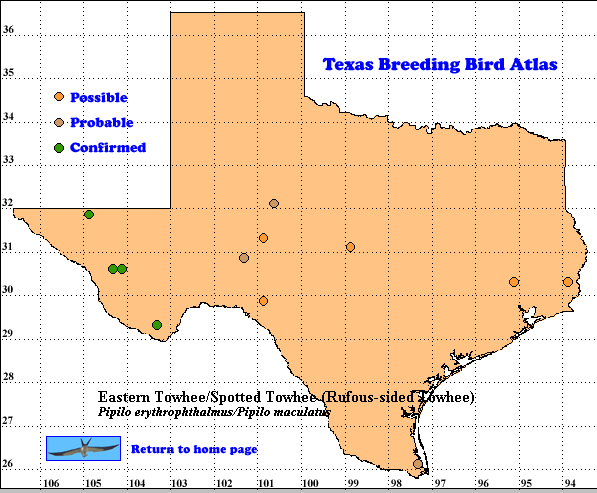The Eastern Towhee was known as Red-eyed Towhee before 1957 when it was lumped with the Spotted Towhee (Pipilo maculatus) of the western United States into the Rufous-sided Towhee, which was split after the completion of the TBBA fieldwork. Thus these two species share a TBBA map. TBBA atlasers were unlikely to mistake Eastern Towhee for any species other than Spotted Towhee and these two species can be distinguished by the prominent white spots on the back of the western bird.
TBBA volunteers did not find any confirmed breeding evidence in areas of Texas where the species winters and the only nest reported by Lockwood and Freeman (2004) was in 1914.
Eastern Towhees wintering in Texas primarily represent the nominate subspecies which migrates in winter to the southeastern United States (Greenlaw 1996a, Pyle 1997).
DISTRIBUTION. In winter the Eastern Towhee is a resident of eastern Texas. Its winter range in Texas overlaps that of the Spotted Towhee (Christmas Bird Count data reported by Greenlaw 1996a, b).
Eastern Towhee breeds from southeastern Manitoba, Minnesota, Wisconsin, lower Michigan, Ontario and Quebec, south to the Gulf Coast from Louisiana to Florida. In winter most northern towhees move south of a line extending through southern Iowa and Illinois, central Indiana, southern Ohio, and northern Virginia and West Virginia (Greenlaw 1996a).
SEASONAL OCCURRENCE. Wintering
Eastern Towhees arrive in eastern Texas as early as mid-October and leave by early April (Lockwood and Freeman 2004).
BREEDING HABITAT. Eastern Towhees breed in brushy woodlands The nest is placed in a depression in the ground or plant litter (scratched out by the pair) with only the rim of the nest showing. The depression is placed under a bush or the nest is built in a bush within 1.5 m (5 ft) of the ground. The female builds the bulky nest in about 5 days. It is constructed of leaves, bark strips, plant stalks, twigs, and grasses, and lined with grasses, hair, bark shreds and pine needles.
She lays 3-4, sometimes 5, grayish or creamy white eggs and incubates the eggs for 12-13 days. Only the female broods the nestlings, which leave the nest when they are 9-11 days old (Oberholser 1974, Harrison 1979, Greenlaw 1996a).
A pair can raise at least 2 broods in a season. The species is a host to Brown-headed Cowbird (Molothrus ater) parasitism (Oberholser 1974, Harrison 1979, Greenlaw 1996a).
STATUS. Lockwood and Freeman (2004) describe Eastern Towhee as an uncommon to rare migrant and winter visitor in the eastern third of Texas. Interestingly these authors note that territorial males have been found in late spring and early summer in the Pineywoods region since the late 1990s, the same area where the 1914 nest was collected.
Breeding Bird Survey data from across the United States and Canada show a statistically significant annual decline of 1.8% per year for the period 1966-2003 (Sauer et al. 2004). Because Eastern Towhee’s rate of decline is relatively slow and because of its reasonably large wintering area in eastern Texas, birdwatchers in this state should be able to enjoy Eastern Towhees for many years to come. The possibility of breeding of the species in Texas is exciting. Text by Robert C. Tweit (2004)
Literature cited:
Greenlaw, J. S. 1996a. Eastern Towhee (Pipilo erythrophthalmus). In The birds of North America, No. 262 (A. Poole and F. Gill, eds.). The Birds of North America, Inc., Philadelphia, PA.
Greenlaw, J. S. 1996b. Spotted Towhee (Pipilo maculatus). In The birds of North America, No. 263 (A. Poole and F. Gill, eds.). The Birds of North America, Inc., Philadelphia, PA.
Harrison, H. H. 1979. A field guide to western birds’ nests. Houghton Mifflin, Boston, MA.
Lockwood, M. W. and B. Freeman. 2004. The TOS handbook of Texas birds. Texas A&M University Press, College Station.
Oberholser, H. C. 1974. The bird life of Texas. University of Texas Press, Austin.
Pyle, P. 1997. Identification guide to North American birds, part 1. Slate Creek Press, Bolinas, CA.
Sauer, J. R., J. E. Hines, and J. Fallon. 2004. The North American Breeding Bird Survey, results and analysis 1966-2003. Version 2004.1. USGS Patuxent Wildlife Research Center, Laurel MD (Web site, http://www.mbr-pwrc.usgs.gov/bbs).

